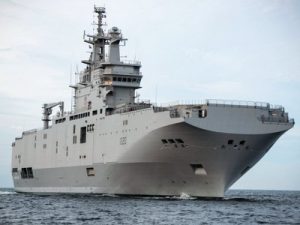2016-09-22 Earlier, Second Line of Defense has raised the question several times about whether the execution of the Mistral deal made any sense in light of Russian actions in Europe.
As Steve Blank noted in 2014:
Whatever the logic of negotiating a deal with Russia in 2011, the strategic situation has changed dramatically.
The seizure of Crimea has returned European direct defense to the table, and the Nordic states in NATO have clearly expressed not only their concern but increased resources for their direct defense and are concerned with Baltic sovereignty.
In a piece published in EUObserver on August 7, 2015, the cancellation of the program by the French government was the focus of attention.
French president Francois Hollande’s office announced on Wednesday (5 August) that a deal has been reached with President Vladimir Putin to pay Russia compensation for cancelling the delivery of two French Mistral warships over the Ukraine crisis.
Russia will be “fully reimbursed” for the two warships, the Elysee Palace said in a statement.
According to Le Figaro, France will pay back a little less than €1bn to Russia, a sum that falls short of what Moscow initially demanded (€1.2bn) and is more than what Paris had said it would pay (€800m).
The payment covers what the Kremlin had already paid to Paris for the ships as well as some costs to do with the training of Russian sailors at Saint-Nazaire, a port town in the west of France, in spring this year.
Both the Kremlin and the French government said they considered the matter closed.
What then transpired was a search for a customer for the ship or to be more accurate prior to the decision the French government sought a buyer to compensate in part for their losses. Reportedly, the final bill for France came in at a little more than $2.6 billion, well above the $1.2 billion Russia originally paid for both.
And according to a story on France 24 published on 8/7/15:
Egypt and Saudi Arabia’s reported interest in the French warships comes as the two Sunni powers have been pushing for a joint Arab force to counter the threat of Islamist militancy on the heels of an Iran nuclear deal that has rattled several Sunni Arab regimes.

On July 30, Egyptian President Abdel Fattah al-Sisi and Saudi Defence Minister and Deputy Crown Prince Mohammed bin Salman signed a “Cairo Declaration” aimed at boosting military ties and economic cooperation between the two countries.
In a statement announcing the signing of the Cairo Declaration, the Egyptian presidential office noted that, “The two sides stressed the need to exert all efforts to boost security and stability in the region, and to work together to protect Arab national security,” in what was widely viewed as a reference to Shiite Iran’s growing influence in the region.
Saudi Arabia has been instrumental in keeping the Egyptian economy afloat following Sisi’s ouster of the democratically elected former Egyptian leader Mohammed Morsi. Despite international condemnation over Morsi’s ouster, oil-rich Saudi Arabia gave Egypt a financial assistance package of more than €3.7 billion (4 billion USD).
The Egyptians have been able to buy not only the two Mistrals but 24 new Rafale jets as well with Saudi help.
And now the Egyptians have taken delivery of the second Mistral-class ship.
According to our partner defenceWEB in a story published on 9/22/16:
The Egyptian Navy has taken delivery of its second and final Mistral class landing helicopter dock, Anwar el-Sadat, while DCNS has floated the first of four Gowind corvettes for Egypt.
The Anwar el-Sadat (L 1020) was handed over to the Egyptian Navy in Saint Nazaire, France, on 16 September in a ceremony attended by Egyptian Navy Chief of Staff Osama Rabie, the chairman and CEO of DCNS, Hervé Guillou, and the president of STX France, Laurent Castaing, together with senior French and Egyptian officials.
It departed St Nazaire on 21 September for Egypt and en route is scheduled to take part in a joint exercise with the French Navy in Toulon. Arrival in Alexandria is scheduled for 6 October.
Shipbuilder DCNS said 180 sailors have been training on the vessel since June in conjunction with DCNS, STX France and Defense Conseil International. In all, close to 400 Egyptian sailors will have received training in this way.
On 10 October 2015, DCNS signed a contract with the Ministry of Defence of the Arab Republic of Egypt for the supply of two Mistral-class Landing Helicopter Dock vessels (LHDs). The delivery of the first of these two helicopter carriers, the LHD Gamal Abdel Nasser (L 1010) took place on 2 June 2016.
But how might Egypt use these ships?
Peter Roberts, a senior research fellow at the Royal United Services Institute and a former Royal Navy officer, said Egypt’s military is shifting its focus, previously on the Sinai, to a more regional outlook.
“It does provide an interesting window into the decision-making of Egypt’s leaders at this moment,” he said.
Analysts said the purchase showed Egypt’s attempt to take a more muscular role in the region, notably with the disintegration of Yemen and Libya.
“The reality is that Egypt isn’t going to try to conquer Libya or Yemen,” said Ben Moores, an analyst with IHS Janes.
“It’s not trying to change those countries.
It’s just trying to keep a lid on them.”
https://www.yahoo.com/news/france-sells-2-disputed-mistral-warships-egypt-112638937.html?ref=gs
And “General Hisham Al-Halabi, military advisor at the Nasser Military Sciences Academy, describes the Mistral as “a military command ship capable of performing major tasks in amphibious operations, equipped with combat management, tactical naval information and satellite communications systems.”
The Russians came out well in the deal for after their Syrian foothold expanded, they were then able to arm the Mistral ships along the lines they intended to do for themselves, but now as part of arms sales relationship with Egypt.

